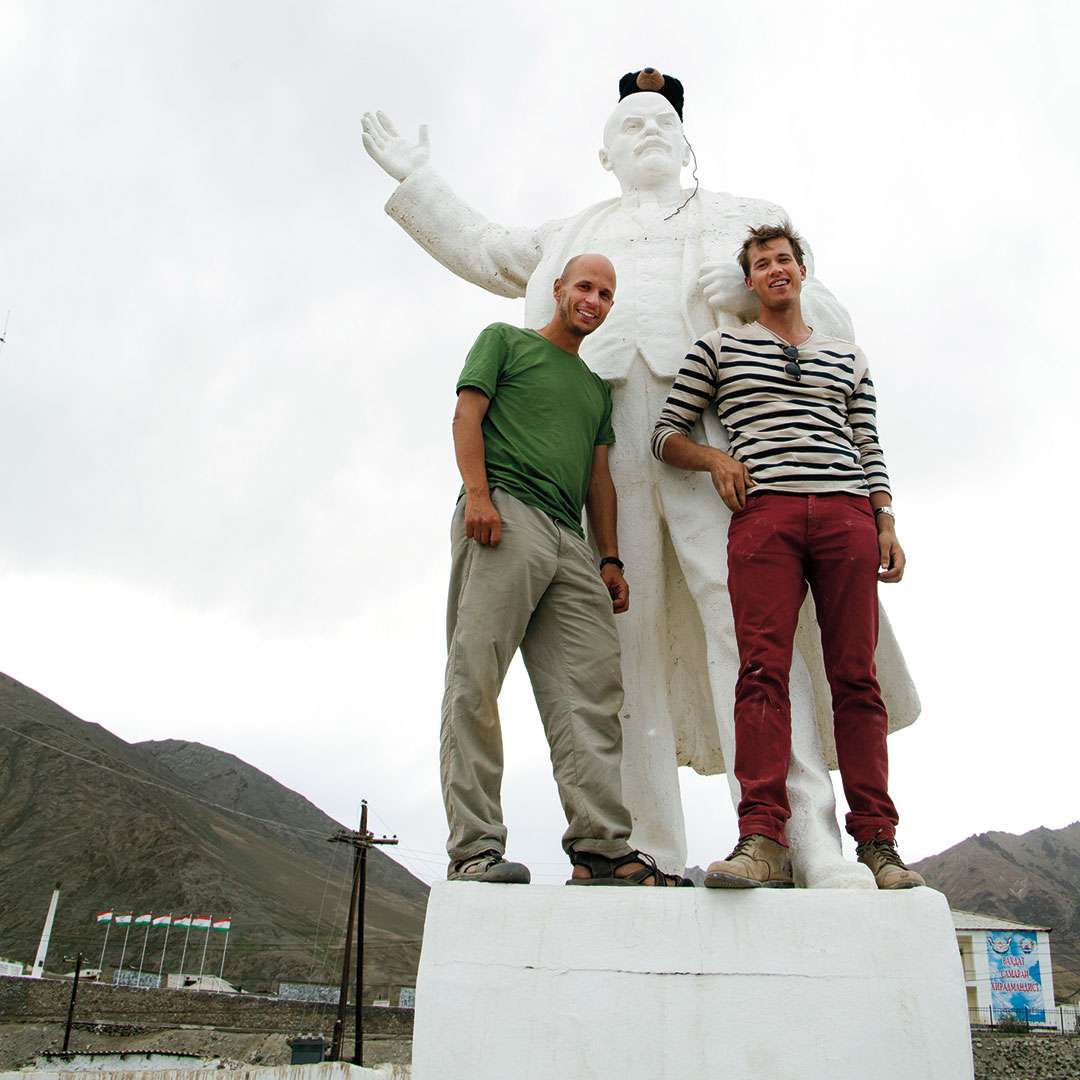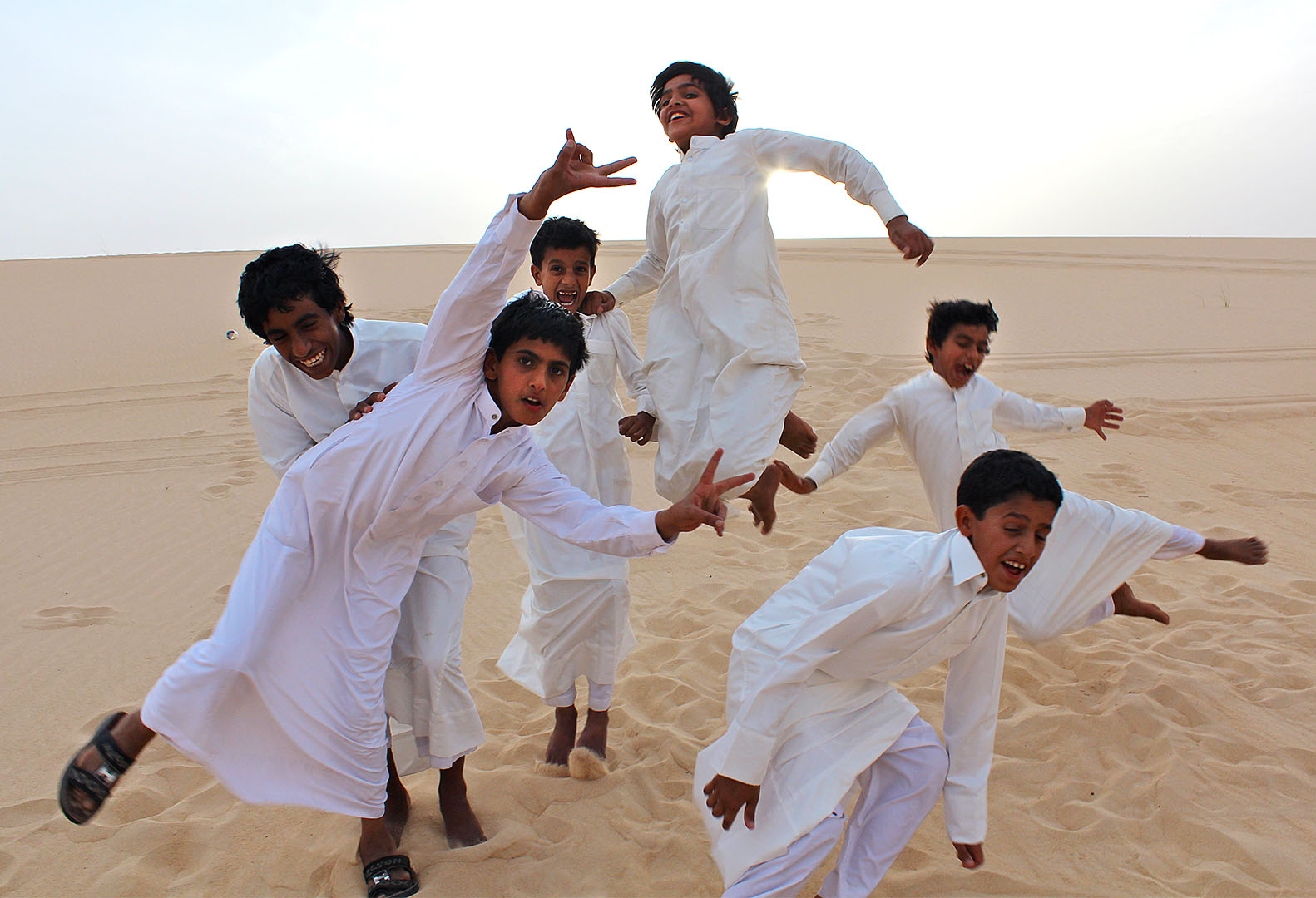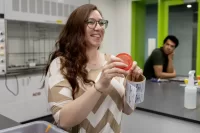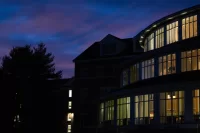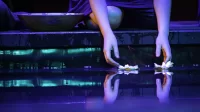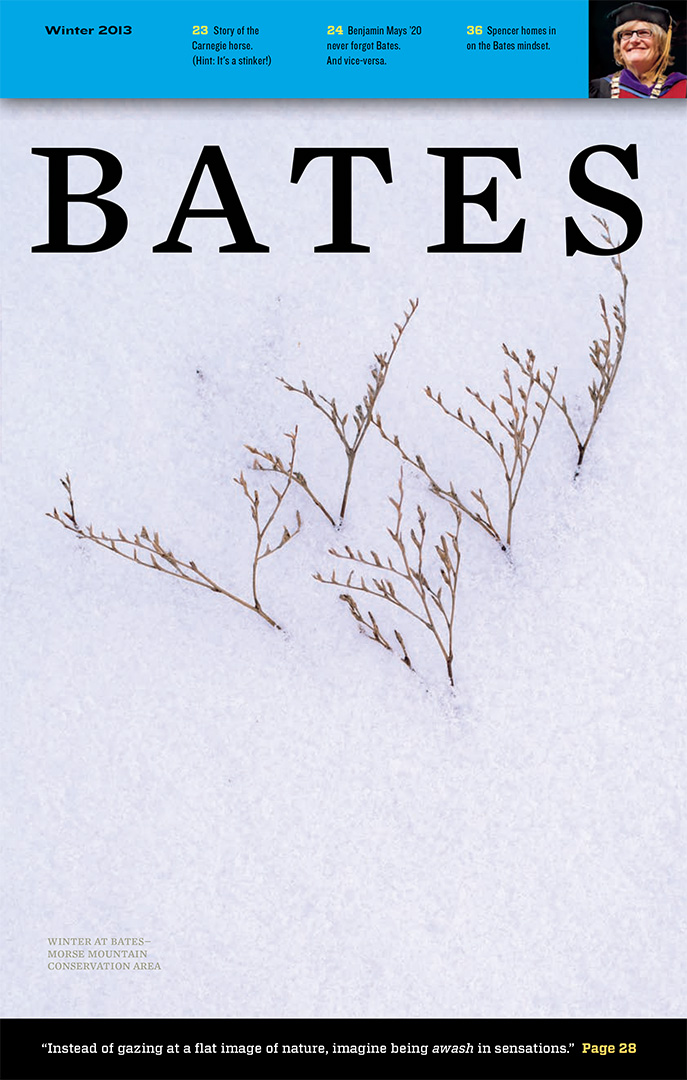
Asking Bates to welcome change, President Hansen made Bates’ framework firmer
Hansen Timeline
October 2002
President Elaine Tuttle Hansen, a scholar of Chaucer and feminist literary theory and former Haverford College provost, is inaugurated on Oct. 26.
January 2003
Bates hosts a major statewide diversity rally that fills and surrounds Merrill Gymnasium with more than 4,000 participants who show vigorous support for the local Somali community in the wake of anti-immigrant actions.
May 2003
Bates approves undertaking a Campus Facilities Master Plan to review campus facilities, infrastructure, and surroundings.
October 2004
In a 20-year study of its optional SAT policy, Bates finds no differences in academic performance or graduation rates between submitters and non-submitters.
Phase I of the Campus Facilities Master Plan envisions New Commons, Alumni Walk, and a residence at 280 College Street, plus academic renovations to Hedge Hall and Roger Williams halls.
November 2004
The public phase begins for the $120 million Campaign for Bates: Endowing Our Values.
February 2005
Begun in 1997, the Edmund S. Muskie Oral History Project concludes with some 440 interviews with those who worked with, knew, or were directly affected by Ed Muskie ’36.
September 2005
Bates announces that Maine students enrolled at New Orleans–area colleges devastated by Hurricane Katrina are welcome to take classes at Bates, without charge. Eighteen Mainers take up the offer.
December 2005
Bates announces that it will purchase electricity from renewable energy sources such as biomass and small hydroelectric generating plants.
Spring 2006
Bates breaks ground for a 152-bed residence at 280 College Street.
July 2006
The Campaign for Bates: Endowing Our Values concludes by surpassing its $120 million goal.
February 2007
President Hansen is among the first to sign the American College & University Presidents’ Climate Commitment, pledging Bates to become carbon neutral.
May 2007
President Hansen convenes her first Presidential Symposium, on diversity and demographics in U.S. higher education.
June 2007
President Hansen announces the innovative “swing dean” program, where a dean recruits students during one year then joins the Dean of Students office to mentor the new students in their first year. The program reflects broader diversity efforts at Bates.
September 2007
Focusing on writing, quantitative skills, and interdisciplinary thinking, revamped General Education requirements go into effect for members of the Class of 2011.
February 2008
Bates opens New Commons. Continuing the college tradition of all students dining together, the facility is an “architectural symbol of what makes Bates so special,” says President Hansen.
September 2008
A gift of $2.5 million boosts the college’s already high use of local and organic food and inspires a yearlong food and sustainability initiative called Nourishing Body and Mind: Bates Contemplates Food.
May 2009
Ben Stein ’09 and Amrit Rupasinghe ’10 defeat Bowdoin to win the NCAA Division III men’s doubles tennis championship.
September 2009
President Hansen announces Choices for Bates, a strategic plan that is the product of two years of campus discussions. Goals are identified around the arts, natural sciences and mathematics, and the Bates learning experience.
October 2009
H1N1 influenza virus hits Bates as 250-plus students report influenza-like illness. All students return to good health.
December 2009
Bates appoints Nancy J. Cable as vice president and dean of enrollment and external affairs. Her newly organized division brings together admission, student financial services, communications and media relations, and career services.
February 2010
Burning biomass for campus heat and some electricity will be key to the college’s newly announced Climate Action Plan, which anticipates college carbon neutrality by 2020.
March 2010
Bates begins the restoration and expansion of two historic buildings, Hedge Hall and Roger Williams Hall, as academic spaces.
August 2010
Bates announces creation of an Office of Intercultural Education to coordinate academic, social, and residential programs for underrepresented student populations.
September 2010
Bates redeploys and expands its career program: the Bates Career Development Center.
October 2010
Bates dedicates a restored and improved Garcelon Field.
March 2011
The Bates faculty announces approval of a major in dance.
April 2011
President Hansen accepts the position of executive director of the Center for Talented Youth at Johns Hopkins.
May 2011
Bates announces formation of a Presidential Search Committee co-chaired by trustees Michael Chu ’80 and Valerie Smith ’75.
Admission reports a triple crown of gains: record applications; a more selective acceptance rate; and a surge in “yield” — the percentage of accepted students who choose Bates.
July 2011
On July 1, Nancy Cable, vice president and dean of enrollment and external affairs, begins her term as interim president of Bates, through June 30, 2012.
‘Alive to Change’
By H. Jay Burns
Photographs by Phyllis Graber Jensen
Nine years ago, Elaine Tuttle Hansen based her inaugural address on a line from Emily Dickinson: “I dwell in possibility.”
Those four words gave Hansen the opportunity to suggest what she believed was possible for Bates: that the college could meet the challenges of the era by cultivating its historic and distinctive capacity of being, as she said, “alive to change.”
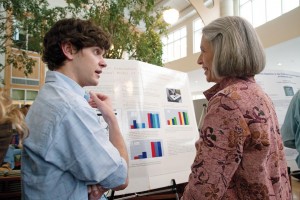
Hansen talks with Owen Harris ’08 about his neuroscience research on therapies for Parkinson’s disease.
In her final Bates interview before assuming duties as executive director of the Center for Talented Youth at The Johns Hopkins University, she spoke with Bates Magazine editor Jay Burns about her 2002 inaugural vision and the realities that followed during her tenure as the seventh president of Bates College.
The key line in your address comes early when you said, “Our goal is to be alive to change.” You then quote cultural theorist Gloria Anzaldua’s comment on personal identity: “Transitions aren’t what we go through. Transitions are what we are.”
The very identity of a college of the liberal arts and sciences is premised on the idea that we are always embracing change. A quarter of our students change each year. At a slower rate, we welcome new faculty and new staff.
A great college embraces new people and their new habits, needs, and expectations. The curricular, educational, and social frameworks of a liberal arts college are just that: frames that contain constant transition.
When I said this in 2002, I had no idea how dramatic the changes were going to be in my nine years at Bates. The economic upheaval beginning in 2008 demonstrates that the possibility of positive and negative change is always out there, and we have to expect it even when we can’t predict it.
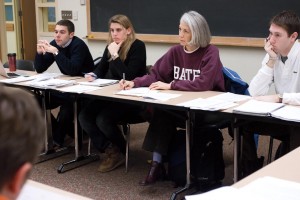
Hansen takes part in an economics class in 2008, part of her annual President for a Day tradition in which she and a student traded places for one day. Photograph by Phyllis Graber Jensen/Bates College.
Early in my presidency we developed a 10-year financial model, which reflects the idea that you have to be proactive and keep adjusting your assumptions as part of the planning process. For example, before the recession, we assumed a 5-percent average annual increase in tuition, which went back to the 1970s. Now we’ve significantly lowered that assumption.
We used to assume an 8-percent total return (taking into account spending) on our endowment; we’ve since incorporated a lower assumption into our 10-year plan.
We had to change our assumptions about campus housing in 2002 because of code issues in our wood-frame houses, and through our Campus Facilities Master Plan, we developed a framework to build the 280 College Street residence, New Commons, and Alumni Walk, and to renovate Garcelon Field as well as Hedge and Roger Williams halls.
We had to learn to make plans. To design yourself as a planner is a little presumptuous — as Henry James wrote, “One’s plan, alas, is one thing and one’s result another.” But I do feel our facilities planning and college planning have been effective.
So we run the college the way we ask students to run their lives. We ask them to develop fundamental skills and attitudes that should help them adapt, be flexible, and learn new things for the new jobs that don’t yet exist. Bates has to do the same thing.
Setting aside the economic meltdown, it should have been clear to anyone in 2002 that liberal arts colleges needed to take steps to face disruptions. We knew the trends putting pressure on liberal arts colleges, such as the decline in the percentage and numbers of students earning liberal arts degrees.
So if we weren’t alive to change in 2002, we needed to be.
You opened your inaugural with a brief comment about rituals: “Rituals afford us prospective opportunities for expressing our hopes and aspirations, our desire for change, and our will to improve.”
In one sense, rituals reassure people. They emphasize, again, the framework that will contain future change — that’s why they’re rituals. At the same time, they always mark change. They are interestingly complicated, almost oxymoronic moments.
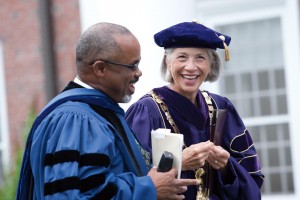
Elaine Hansen laughs with Marcus Bruce ’77, the Benjamin Mays Professor of Religious Studies, prior to Convocation 2010. Photograph by Phyllis Graber Jensen/Bates College.
In a similar way, I have found great pleasure in observing the construction on campus, something I hadn’t anticipated. Perhaps this is because new buildings and renovations create an image of stability yet they reflect great change. It’s a nice point-counterpoint.
Every Bates president has wrestled in some way or another with the question of diversity and inclusion on this campus. In your inaugural, you described the challenge of creating and recreating a college that feels open both to those who never doubted attending college and to “those who have not been able to feel so confident about their destinies” and who “bring a wider variety of experience and perspective to the campus.” What does it means today for Bates to “invite those who have not been able to feel so confident about their destiny”?
At our 2007 Presidential Symposium, “A College for Coming Time: Diversity and the Changing Demographics of Higher Education,” I noted how many colleges and universities today are able to tell of both aspirations and frustrations around diversity.
Bates is alive to this challenge. We know what it is to seek change while staying firm. Of all American colleges, Bates was among the very few that radically put its stamp on diversity long before anyone used that term. It’s part of our sturdy framework.
But for a college founded by abolitionists, always open to women, and known for recruiting freed slaves — what does that foundation mean in the early 21st century, when the world has changed so much around us? The value and definition of diversity and inclusion is very different now than in 1855 or in 1945 with the return of students from World War II or in the 1970s when most of the baby boomers were going to college.
At the symposium, we focused on the changing demographics. We know that fostering diversity and inclusion is as tough as or tougher now than it used to be. The competition for students is tougher. The financial challenge of providing need-based aid for students is greater. Maine is still mostly a white state and located in a region of the U.S. where high school enrollments have been decreasing.
And yet, if I’m proud of anything during my presidency, I am proud that so many people took on the task of working harder to sustain our principles, and prepare all students for the future. Bates is more diverse now than ever before, and our incoming Class of 2015 continues this trend: 103 U.S. multicultural students, up from 86 last year, a number that itself represented sustained improvement from prior years. Our increased diversity will continue to affect the culture of the college in ways we can anticipate and in ways we cannot.
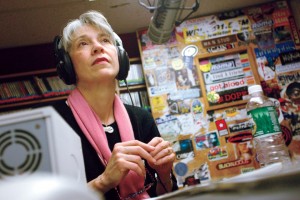
Hansen sits for a WRBC student interview shortly after her arrival in February 2003. Photograph by Phyllis Graber Jensen/Bates College.
In 2002, you said that while society places value on a college education to an individual, “there is no consensus about the social or civic value of higher education” generally.
Society’s understanding of the purpose and value of higher education has only gotten even less clear.
As an example, recall that in February 2009 President Obama called for all Americans to commit to attending at least one year of college. The statement was met with praise by college leaders; ostensibly, the president’s speech expressed a consensus that American higher education represents a great public good.
But when you look at reaction to the president’s suggestions — one critic dismissed it as just another government subsidy — you realize there is even less alignment between our view of higher education, as both beneficial to the individual and to society, and society’s diminishing belief that higher education is a public good that fosters social and human progress.
The call for all Americans to commit to a year of college, while praiseworthy, does diffuse and make much more complex the whole concept of what going to college means in our country. If we have a country that is committed to going to college, yet no agreement on what that means, that pushes us further from a consensus of the public value of higher education.
This lack of consensus of the value of a college education is seen in the national discussion of three-year baccalaureate degree programs, a discussion I’ve joined partly because Bates has a three-year option created by President Phillips in the 1960s.
While I do understand that a three-year option is about money, an important consideration, the discussion suggests that a U.S. college education is something that can or should be made briefer. Walking to Gate 4 at LaGuardia Airport recently, I saw a sign in front of a telecom store: “Anything worth doing is worth doing faster.”
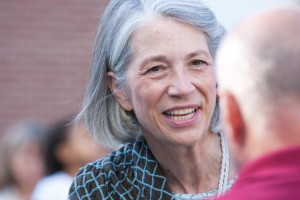
Hansen greets a Bates parent during first-year orientation. Photograph by Phyllis Graber Jensen/Bates College.
What I view as the purpose of a higher education is opposite from the idea of getting it over with as quickly as possible. If you attempt to measure our value by that idea, you will never believe in Bates. Among other things, we are trying to cultivate the ability to listen, focus, and slow down in a world of, as writer Linda Stone said, “continuous partial attention.”
President George Colby Chase, whom you quoted at length in your inaugural, said that Bates must safeguard against existing “to gratify the selfish instincts of the more fortunate.” Bates should develop citizens who are “fit exponents” to increase the world’s “sweetness and light.” If Bates long ago evolved from the teacher-preacher culture of alumni professions, how does Bates prepare people to help society achieve greater “sweetness and light”?
The teacher-preacher culture has been part of some enduring narratives among Bates alumni. One particularly enduring Bates story that alumni in finance and business tell with real emotion is their feeling that they somehow fell from the high aspirations of the preacher-teacher model by pursuing lucrative careers. This narrative seems quite strong among alums of the 1980s, though some felt it more than others.
Today, I believe we see absolutely no evidence for this narrative on campus. We see strength in the arts and encouragement for students to pursue great careers in the arts. And we have strength in the economics department and encouragement there.
Through both our heritage and distinctive current programs, like the Harward Center for Community Partnerships, Bates will always have a culture of social engagement. We tend to seek and attract students who want to do good work, and our seniors desire to find work after graduation that aligns with their experience of having done meaningful and well-aligned academic work while at Bates. As President Chase said, our graduates seek work that “exemplifies to the less favored the meaning and uses of life at its best.”
At the same time, Bates has taken great strides in better equipping students to discover and pursue careers that help them make full use of their new liberal arts habits and skills. This past year, we reorganized the Bates career program and redeployed it as the Bates Career Development Center. Again, this is part of Bates being a place that looks forward, anticipates, plans.
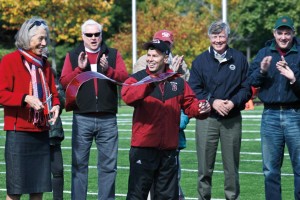
Hansen and Director of Athletics Kevin McHugh cut the ribbon at the dedication of renovated Garcelon Field in 2010. Photograph by Janet Cuimmei P’12.
So, in terms of helping society achieve greater “sweetness and light,” maybe your calling is to a profession directly connected to helping people. Or maybe your calling is to a lucrative profession. Either way, I hear our alumni talking passionately about how their Bates education has helped them be principled, bold, and engaged leaders in their chosen field and in their communities. And I hear the impulse to do good work when alumni talk about helping students and young alumni. This is their expression of doing good work.
What I don’t see at Bates is one prescription for how you do good work. And there shouldn’t be one prescription, in my view.
In 2002, you offered the idea that Bates campus life should be about “experimentation and creativity,” with room for “both disagreement and mistakes within a certain zone of temporary safety [and] provisional protection.” What have been the challenges? The successes?
If we look at that statement through the lens of residential life, one challenge is no different than ever before. We have 2,000 students, 1,700 of whom are in residence, all age 18 to 22!
Still, I believe we have altered the atmosphere in our residence halls. This is not about casting aspersions on prior groups of students. It’s what Bates has done to help students themselves take responsibility for improving the reality of their residential life.
It has helped that Bates built a new residence hall at 280 College Street. Its flexible, welcoming, and interactive spaces help communicate the fact that a student’s residential life is fully connected to other parts of Bates life.
We have improved the training of junior advisers and residence coordinators, and Dean of Students Tedd Goundie has the perspective that student leaders can and should be empowered to be more accountable for the actions, programs, and outcomes in the residences.
Of course, this is a lot to ask of our students. It can look like Bates is abdicating our responsibilities as adults. But the successes, when they come, are proportional to the amount we are asking students to invest in their community. I mean, talk about building!
Being alive to change includes updating our understanding of generational perspectives. In your inauguration, you spoke of young people being highly able and having an extreme emphasis on “self” and “selfhood” but not, ironically, possessing great self-awareness.
When I quoted author and child psychiatrist Robert Coles in that part of my inaugural, I was worried about children who grow up having cultivated perfection their whole lives. They have, as Coles said, “very definite notions” of what should come to them. They are attuned to accomplishing tasks but not attuned to self-reflection. So when they fail, as we all do at some point, do they have the ability not only to start over but also to learn something important about themselves?
At our annual mid-May Senior–Trustee Luncheon, over and over we hear seniors reflect on the incredible value of taking risks and achieving — and the value of not being the best. And these are our stars. They will have great successes in their lives. But what they appreciate, in addition to high-powered academic excellence, is that Bates offered a path for them to try something new — join a club, sports team, or musical group — that requires them to stretch and risk not being the star.
Sometimes it is a challenge to convey this part of the Bates culture and not make it sound like we encourage dabbling. It’s not that. When you listen to our seniors, they are very intense and serious about what they have pursued at Bates. Shot put All-American Liz Wanless ’04 used to say that she worked hard at throwing after being inspired by how so many people seemed to have their own passion at Bates: “I’m just another person trying to achieve a goal,” she’d say.
I can hear in my mind other variations of this — “I learned that who I am includes this passion for doing something that no one else was going to expect me to do.” America used to hold this concept up as something highly valuable: the amateur ideal. By trying many things, failing at some, you get a sense of who you are, particularly in relation to others, and what you really love.
This is Bates: broad-scale participation, passion, intensity — our Amore ac Studio.
